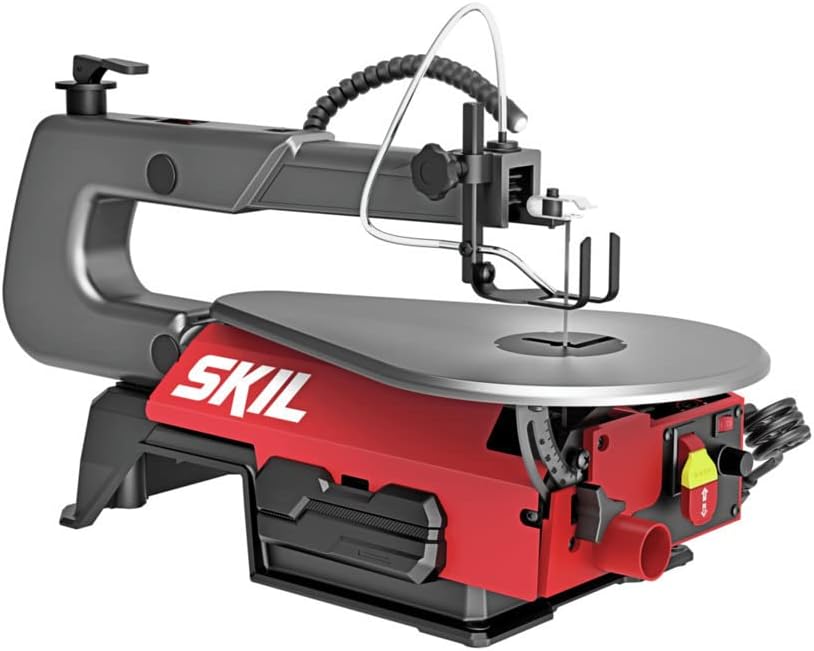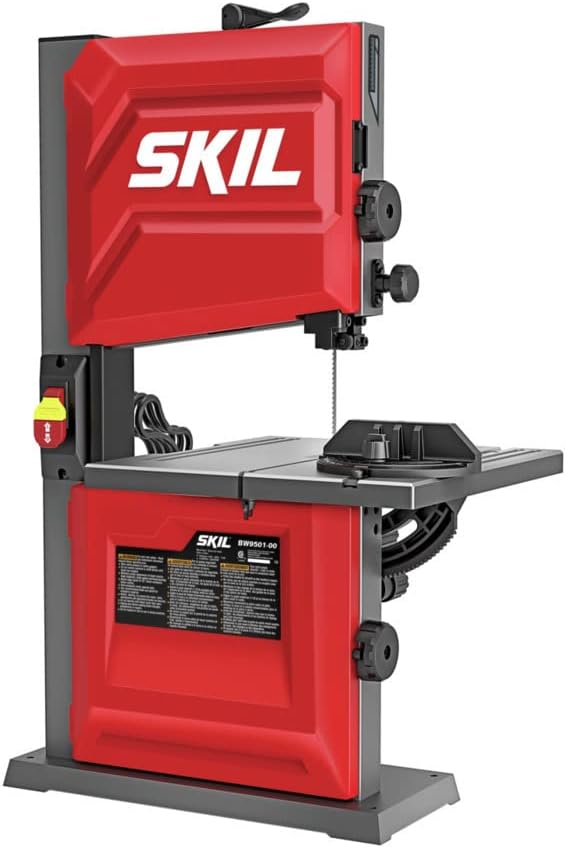Scroll saws and band saws are two common woodworking saws used for detailed cutting work. While they share some similarities, there are key differences between these two saw types in terms of their build, capabilities, blade movement, and ideal uses.
This comprehensive guide will examine all the major points of distinction between scroll saws and band saws to help woodworkers select which is right for their needs.
Scroll Saw Overview

First, let’s cover some background on what exactly a scroll saw is and how it works.
A scroll saw is a small electric or pedal-operated saw used for precisely cutting curved, intricate, and internal shapes in woodworking projects. Here are the key features and capabilities of scroll saws:
- Small tabletop size with upright blade
- Uses ultra-fine pinless or pin-end scroll saw blades
- Blade moves up and down rapidly to saw intricate details
- Excellent for detailed fretwork, lacework, marquetry, inlay, and scrollwork cuts
- Can cut thick wood up to 2” depending on model
- Cuts very precise, clean curves and lines
Scroll saws are versatile for not just scrolling work but any project requiring delicate and complex cuts. The thin blade allows you to cut tight interior cutouts by feeding the wood through the minuscule blade opening.
Now let’s look at how band saws differ from scroll saws.
Band Saw Overview

Band saws are larger saws that use a continuous looping blade to cut various materials. Here are the defining features of a band saw:
- Larger saw with a table and enclosed blade housing
- Uses a flexible band saw blade looped around two wheels
- Blade constantly loops vertically down through the cutting table
- Good for straight cuts, curves, irregular cuts on larger stock
- Can cut thick wood 6” or greater depending on model
- Cuts faster and rougher than scroll saws
Band saws are workshop saws designed for rapid cutting of broad curves and irregular shapes in sizable workpieces. The gap between the blade wheels allows cutting of thicker material.
Now that we’ve provided an overview of each saw type, let’s dive into an in-depth feature comparison between scroll saws and band saws.
Detailed Feature Comparison
To give a full picture of how scroll saws and band saws differ, below we’ll explore all the major features side-by-side:
| Feature | Scroll Saw | Band Saw |
|---|---|---|
| Cutting Action | Up and down rapidly reciprocating blade motion | Continuous looping downwards blade motion |
| Maximum Cut Depth | Up to 2” depending on model | Up to 6”+ depending on model |
| Blade Size/Type | Ultra-fine pinless or pin-end, #0-3 reverse tooth | 1/8″ to 1″ width, variable TPI |
| Table Size | Small, ~16″ x 11″ average | Large, 20”+ depth and width |
| Machine Weight | Under 50 lbs typically | 80 – 500+ lbs |
| Dust Collection | Internal blade gullets, some models have ports | Requires external dust collection |
| Power Source | Electric or pedal operated | Electric motor only |
| Portability | Very portable desktop size | Stationary cabinet or benchtop style |
| Used For | Intricate scrolling/fretwork | General curves, irregular cuts |
| Typical Cuts | Tight curves, interior cutouts | Broad curves, angles |
| Common Materials | Soft/hard wood, plastics | Wood, metal, tile, composites |
As shown by the table, while scroll saws and band saws both specialize in curved cuts, they differ considerably in their detailed design, capabilities, and usage.
Some key differences to note:
- Scroll saws use a very fine blade with up/down motion perfect for delicate scrolling tasks. Band saws use a wider blade in a continuous loop for fast general cutting.
- Band saws can cut much thicker material thanks to the gap between the blade wheels. Scroll saws max out around 2 inches.
- Scroll saws are small, portable desktop units good for crafts. Band saws come as large workshop cabinet saws for heavy duty use.
- Band saws require external dust collection while some scroll saws collect dust internally.
Now that we’ve directly compared the features, let’s look closer at the different blade designs used by each saw.
Scroll Saw vs Band Saw Blades
One significant difference between scroll saws and band saws lies in the specialized blades required for each machine:
Scroll Saw Blades
- Very narrow width, usually below 1/8″
- Come in standard #0, #1, #2, #3 sizes
- Also available in reverse tooth pattern for scrolling
- Pinned or pinless versions available
- Designed for low tension up/down movement
- Sold in packs of dozens at low cost
Band Saw Blades
- Much wider, from 1/8″ to 1″+
- Available in variable tooth per inch (TPI) sizes
- Comes in standard and exotic materials
- Requires high tension for continuous looping
- Priced and sold individually or in sets
- Welded or brazed construction
As you can see, scroll saw blades are designed to be ultra-fine and narrow for those delicate scrolling cuts. Band saw blades are more heavy duty to withstand the high pressures involved in constantly looping around the wheels.
Now let’s compare the types of cuts each excels at.
Cutting Comparison
Scroll saws and band saws differ considerably in the types of cuts they specialize in:
Scroll Saw CuttingCapabilities
- Tight curves and circles down to 1/2” diameter
- Intricate fretwork patterns with sharp angles
- Interior cutouts by feeding material through table slit
- Detail work like lace patterns and marquetry
- Can cut wood up to approximately 2” thick
- Delicate hobbyist to semi-professional use
Band Saw Cutting Capabilities
- Broad curves with minimum 2” radius
- Irregular non-straight cuts
- Angle cuts up to 60 degrees
- Cut wood over 6” thick depending on model
- Rapid cutting through thick stock
- Professional to industrial use
While scroll saws are made for delicate scrolling tasks, band saws are optimized for rapidly cutting all types of general curves, shapes, and angles through thick materials.
Now let’s compare some pros and cons of each saw type.
Scroll Saw Pros and Cons
| Pros | Cons |
|---|---|
| Extremely precise intricate cuts | Limited thickness cutting ability |
| Cuts thick material despite small blade | Not designed for general purpose cutting |
| Easy to change blade quickly | Primarily used for detailed scrolling work |
| Very quiet operation | Cutting area restricted to table size |
| Compact and portable | No dust collection on some models |
| Affordable models available |
Band Saw Pros and Cons
| Pros | Cons |
|---|---|
| Cut large stock effortlessly | Not capable of delicate detailed cuts |
| Rapid cutting speeds | Changing blade is a slower process |
| Cut a wide range of materials | Larger machine takes up more space |
| Excellent for curves, angles, irregular shapes | More expensive models |
| Available in a wide range of sizes | Requires dust collection setup |
As shown by the pros and cons, scroll saws excel at ultra-fine delicate work while band saws are preferable for rapid rough cuts through thick stock.
Now let’s compare some sample projects and uses for each saw.
Scroll Saw Uses and Projects
Here are common uses and projects perfectly suited to the scroll saw:
- Scrollwork – Intricate decorative shapes cut into wood.
- Fretwork – Lacy, open carved patterns like snowflakes or lace.
- Marquetry – Wood inlay artwork made from veneers.
- Segmentation – Creating 3D forms by stacking layers of cut wood.
- Intarsia – Interlocking cut wood mosaic pictures and shapes.
- Inlay – Cutting custom shaped inlay cavities to embed materials.
- Hobby/craft woodworking – Cutting parts for toys, models, home decor.
- Jewelry making – Cutting wooden jewelry elements and inlay.
The scroll saw’s finesse is ideal for crafting projects where delicate cutting precision is needed.
Band Saw Uses and Projects
Here are some typical uses and applications for band saws:
- Resawing lumber into thinner boards
- Cutting irregular shapes from large stock
- Cutting rounded forms like chair legs and table edges
- Cutting fretboard or instrument body blanks
- Many metal cutting tasks with appropriate blade
- Rapid prototyping of parts from raw materials
- Cutting thick materials that other saws can’t handle
- Boat building tasks like cutting hull planks and designs
Band saws are workshop saws designed for rapid, rough cuts through large stock where detail precision is not required.
Scroll Saw Tips and Recommendations
Here are some tips specific to scroll saws for best practices:
- Select the right blade width and TPI for your material thickness and desired cut
- Upgrade to a saw allowing quick blade changes without tools for easy swapping
- Reduce blade tension when cutting brittle materials to avoid cracking
- Back up delicate fretwork with low tack tape for support when cutting
- Use combination blade strokes to cut corners and do detail worm hole cuts
- Angle blade slightly when doing intricate marquetry or inlay
- Check blade for burring periodically and clean off with jeweler’s cloth
Following these tips will lead to enhanced scroll saw productivity and cut quality.
Band Saw Tips and Recommendations
Here are some band saw tips for optimal performance:
- Set blade tension just high enough to prevent slipping and wandering
- Select wide blades for curved cuts, narrow for straight cuts
- Use a relief cut when cutting irregular shapes to prevent blade binding
- Cut slowly when cutting brittle materials to avoid cracking and chipping
- Use a high TPI blade when cutting metal to get a smooth cut edge
- Add a taller riser block to cut thicker material if needed
- Check that wheel bearings are lubricated and blade runs centered
- Adjust blade guides close to the stock to increase cutting accuracy
Adhering to these band saw guidelines will maximize cutting efficiency and precision.
Summary and Recommendations
In summary, while scroll saws and band saws both cut curves, they are designed for very different tasks:
- Scroll saws specialize in delicate curved, interior, and scrolling cuts in thinner material. Excellent for detailed crafting work.
- Band saws rapidly cut broader curves, irregular shapes, and angles in much thicker stock. Made for workshop tasks.
For miniature sized projects requiring intricate curved cuts through material under 2” thick, choose a scroll saw. For larger workpieces and cutting jobs where speed is important but precision less vital, reach for a band saw.
Hopefully this detailed comparative guide gives you a clear understanding of when you need a scroll saw versus a band saw. Both are extremely useful for different segments of woodworking. Choose wisely based on the types of projects and cuts you expect to take on.

